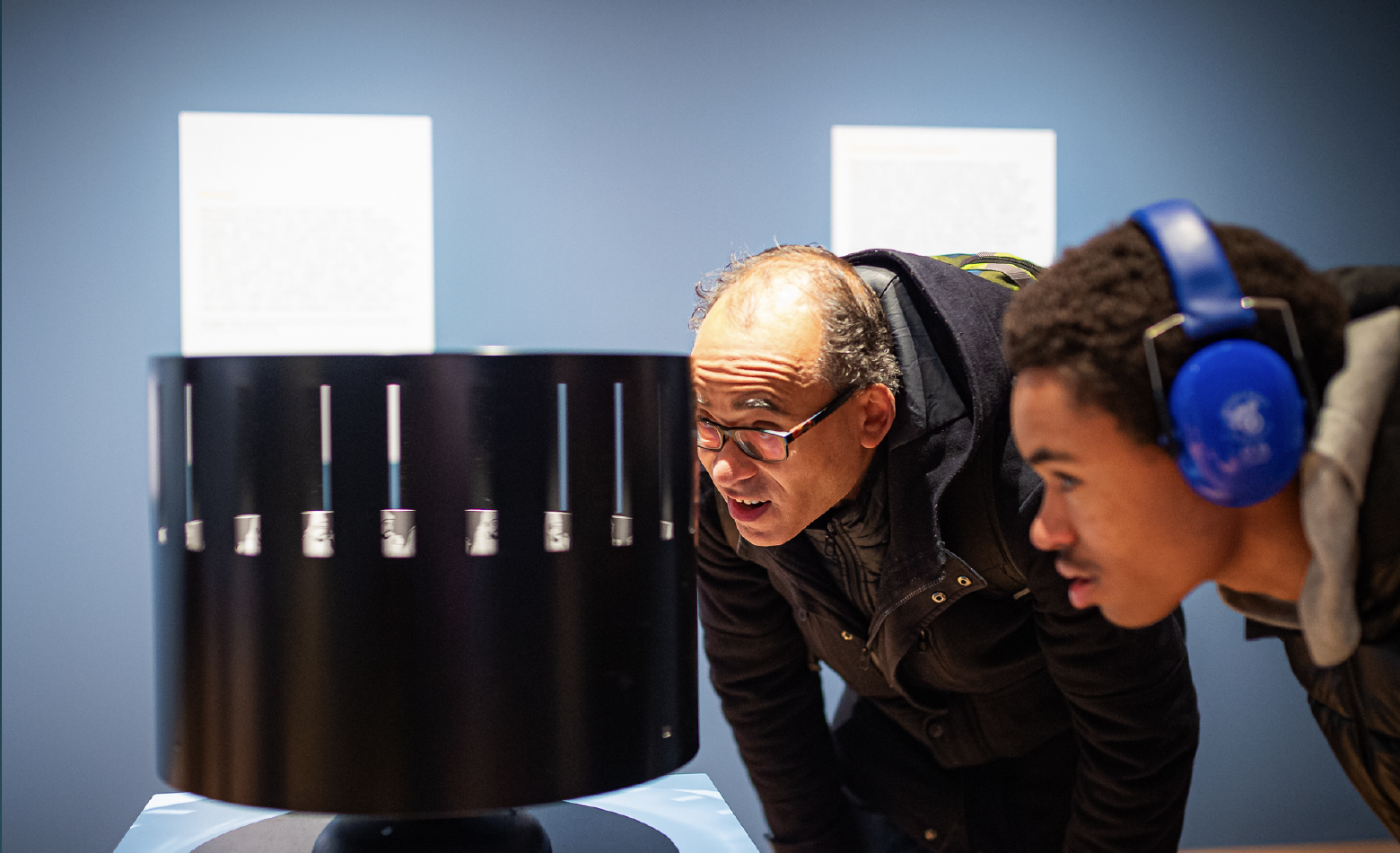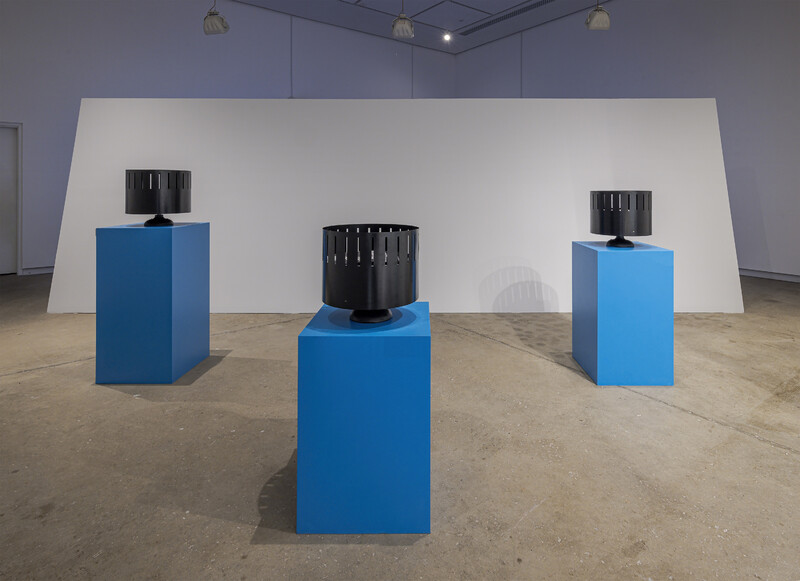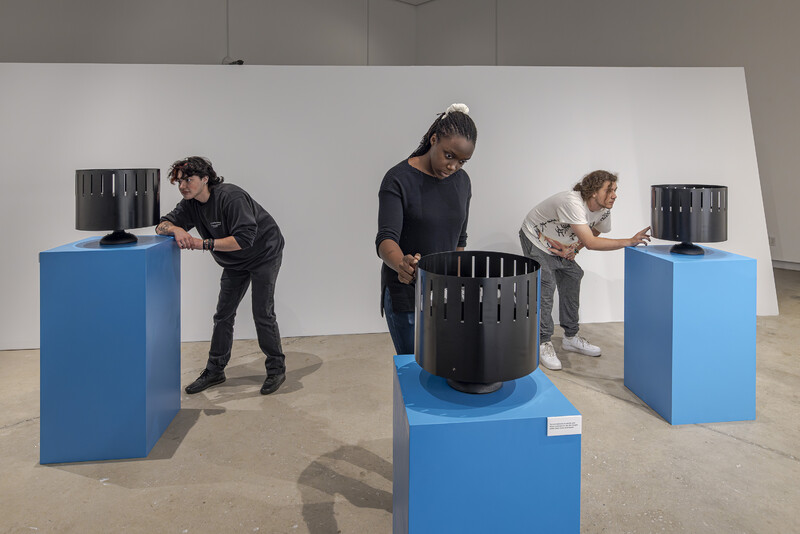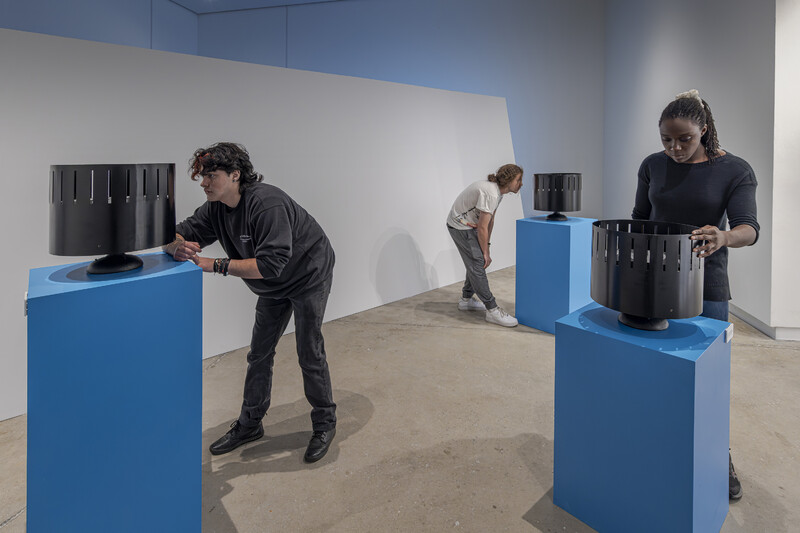Descriptive Audio
The Neurocultures Collective and Steven Eastwood, Zoetropes, descriptive audio, 01:42. Delivered by Research and Outreach Assistant Liam Mullen.

Descriptive Audio Transcript
The Blackwood Gallery’s floorplan is a large, square-shaped space with high-ceilings. For the exhibition, STIM CINEMA, the gallery is dimly lit, and sectioned off into two, mediated zones of engagement: an anterior space designated for sculpture, and a posterior alcove for viewing audio-visual work.
Within the sculptural space, there are three cyan plinths standing
at various heights to accommodate myriad viewing vantages.
The plinths are scattered in a rough, triangular formation to
create a steady flow of movement between, around, and across
the works. On top of each plinth rests a zoetrope: an early
animation device that mounts single-frame illustrated images in
a sequence, lining the inside of a vented, cylindrical vessel, that,
when rotated on a turntable, simulates movement. The zoetropes
are made from black-painted, bent steel cylinder with small
rectangular vents sliced vertically along the walls of the object.
These openings act as the aperture through which we may view
the animated loop.
On the lowest plinth, the sequence depicts a person repeatedly
pulling a box from a shelf. On the intermediary plinth, a person
repeats a calming gesture, gently tracing the gap between their
collarbone with their hand. On the tallest plinth: a swirl of soft
serve ice cream endlessly replenishes itself. Each animated loop
is gathered from the video installation, STIM CINEMA, presented
on the other side of the wall.
Installation Views




Zoetropes
Sam Chown Ahern, a visual artist working with drawing, illustration, bookworks, photography and sound. Sam was also the co-host of the CH4 documentary Are You Autistic?;
Lucy Walker, a member of the Project Artworks Collective, working with costume and puppet making, drawing and small set building, all involving alter egos;
Georgia Kumari Bradburn, a short filmmaker whose work focuses on metamorphosis and transformation, and an embodied autistic phenomenology of cinema;
Robin Elliot-Knowles, an associate artist of the Project Artworks Collective, whose practice includes painting, drawing, and graphic-novels, considering themes of intersectionality, post-colonialism, and transgender (Robin is also the curator of the B-Movie Fan Club, a monthly screening at Hastings Electric Palace);
Benjamin Brown, a film programmer/curator whose creative practice involves drawing, video, and photography, with a particular focus on sensory ethnography (Ben also runs a film club called Citizen Autistic).
In 2018, The Blackwood presented Steven Eastwood’s THE INTERVAL AND THE INSTANT in the 5-part exhibition series Take Care, curated by Letters & Handshakes (Greig de Peuter & Christine Shaw). Steven’s participation in Take Care included “The Interval and the Instant: Inscribing Death and Dying,” a conversation with Dr. Naheed Dosani, Dr. Jenny Lau, and Dr. Kim Wedger as part of the the 3-day event Running with Concepts: The Empathic Edition.
Repetitive movements from the Collective’s films are transformed as drawings spinning in a set of zoetropes, sculptural objects that represent the very first form of moving images. Rather than familiar sequences of galloping horses and juggling clowns, these zoetropes depict subtle gestures glimpsed in the video installation: soft-serve ice cream being served, a figure making a self-soothing arm movement, and a box getting placed onto a shelf. These looping animations highlight that the joy found in repetition is not only central to autistic experience but also embedded in the origins of cinema itself. The inclination to watch an action repeated has deep roots: first fulfilled by devices like the 1830s zoetrope, early experimental filmmakers continued this exploration with mesmerizing circular imagery. Today, an interest in looping remains prevalent through the widespread popularity of GIFs. The Neurocultures Collective begins here—at the intersection of stimming, GIFs, early cinema, and the avant-garde—envisioning a world where stimming is embraced as a desirable state.

The Blackwood
University of Toronto Mississauga
3359 Mississauga Road
Mississauga, ON L5L 1C6
[email protected]
(905) 828-3789
The galleries are open. Hours of operation: Monday–Saturday, 12–5pm.
Holiday hours: regular gallery hours are in effect until and including Saturday, December 6. The galleries will then be closed for the holidays, except for regular hours on Saturday, December 13. In 2026, the galleries reopen Monday, January 5.
Facebook | Twitter | Instagram
Sign up to receive our newsletter.
The Blackwood is situated on the Territory of the Mississaugas of the Credit, Seneca, and Huron-Wendat.